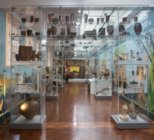Working in partnership with Bolton Library and Museum Services, The Friends of Smithills Hall have created a new permanent exhibition to document and bring to life a building integral to the town’s history.
The exhibition will introduce visitors to some of the powerful families who owned the house and estate over the centuries, but also the lives of the servants who worked behind the scenes.
Visitors will learn about the first owners of the hall, an influential, aristocratic family called the Radcliffes and their lasting legacy, the Great Hall, which they rebuilt in stone when they took possession of the estate in the early 1300s. The Great Hall was where the family slept and ate its meals. However, it was also a seat of government. From here, the Radcliffes administered their extensive landholdings and dispensed local justice.

The story of Bolton’s first and only martyr, George Marsh, will also feature in the exhibition. Marsh, a local preacher, was a victim of the persecution of Protestants during the reign of Queen Mary with Smithills Hall playing a central part in his demise.
In the spring of 1554, Lord Derby, the Lord Lieutenant of Lancashire, ordered George Marsh to be apprehended on charges of heresy if he appeared in Bolton. It was at Smithills Hall where he presented himself before Robert Barton, the owner of the estate and local Justice of the Peace. He was held and questioned about his ‘heretical’ religious beliefs in one of the upper rooms at Smithills. The legend has it that as Marsh was being led from the hall he stamped his foot on a flagstone, leaving a mark that has remained there ever since as a declaration of his steadfast faith.
Bolton Council’s Cabinet Member for Culture, Youth and Sport, Coun John Byrne, said: “We’re very fortunate to have such a wonderful asset like Smithills Hall in Bolton and even more fortunate to have the support of the Friends of Smithills Hall, who volunteer their time to ensure the history of the hall stays alive.
“We’ve worked closely with the Friends group to create a new, permanent exhibition which documents the lives, loves and work of those families who have been involved with the building over the past 700 and more. The hall has a fascinating history which will appeal to all ages.”
Smithills Hall has always been a place of work as well as a family home. A new area called ‘Working Life’ will explore the hall’s connection to local industry. When the Barton family owned the manor in the 1500s, the main industries were farming and weaving. By the time Richard Shuttleworth became Lord of the Manor in 1582 the estate had its own mill.
“We hope that it entices people to visit and experience the rich history that the hall has to offer as well as finding out more about the Friends of Smithills Hall,” said David Williams, Chairman of Friends of Smithills Hall.
The lives of local workers changed dramatically with the arrival of the Ainsworth family in the 1800s. Under the Ainsworths the hall became the centre of a hugely successful bleaching business.
Smithills Hall is open Wednesday to Friday, 10am to 3pm and on Sunday 12pm to 4pm.







